24.2 Preferences: General
Table 24-1 Preferences: General
24.2.1 Appearance
Figure 24-1 Preferences: Appearance

Table 24-2 Preferences: Appearance
Colors and Fonts
To change a color:
-
Expand an option (for example, ).
-
Select an item (for example, ).
-
Click the color button.

-
Select a color from the Color palette, then click .
To change a font:
-
Expand an option (for example, ).
-
Select an item (for example, ).
-
Click .
-
Select a font, style, and size, then click .
24.2.2 Capabilities
Currently, this section relates to Eclipse functionality. Designer functionality will be implemented later.
Prompt When Enabling Capabilities
Eclipse lets you turn off capabilities. However, Eclipse sometimes detects that you need the capability, depending on how you use the product, and automatically turns the capability on again. This feature doesn’t apply to Designer 2.0.
24.2.3 Compare/Patch
This Eclipse functionality customizes the behavior of the comparison editor. When you select to compare or synchronize two or more resources in the Workbench, one or more comparison editors usually open.
Table 24-3 Preferences: Compare/Patch
24.2.4 Content Types
Table 24-4 Preferences: Content Types
24.2.5 Editors
Table 24-5 Preferences: Editors
File Associations
Enables you to associate editors (whether internally installed in the Designer, or an external application) with file types (extensions) so that you can edit files.
To find out which editor is associated with a file type, select the file type. For example, a .docgen file type is associated with Style Editor, but a .scriptpolicy file type is associated with Policy Builder.
To associate an additional editor with a file type:
-
Select the file type.
-
In the Associated Editors pane, click .
-
Select an additional editor, then click twice.
To add a file type:
-
In the pane, click .
-
Type the extension (for example, .doc) for the file type, then click .
-
In the pane, click .
-
Select an editor for that file type, then click twice.
Text Editors
Table 24-6 Preferences: Text Editor
24.2.6 Keys
Enables you to view a table of all of the keyboard mappings, change those mappings, and add new mappings.
24.2.7 Perspectives
Table 24-7 Preferences: Perspectives
24.2.8 Startup and Shutdown
Table 24-8 Preferences: Startup and Shutdown
24.2.9 Web Browser
Table 24-9 Preferences: Web Browser
